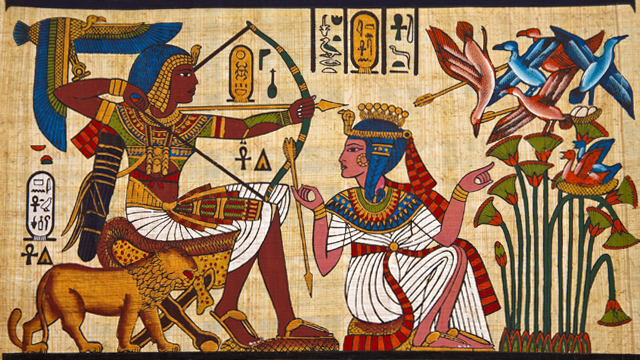A range of media was used to create art by the Ancient Egyptians. These multiple outlets of art included papyrus paper, wood, stone, and also painting [2].
Temples and palaces were the typical places of where the most paintings occurred. As noticed in the photographs to the left and below, when people, animals, or objects were painted, they were always painted from the side. The painting featured below is a portrait of Nefertari. She was the first wife of Ramesses the Great and Egyptian queen. [3] Another art form constructed for the queen was the Abu Simbel. These are two large temples carved into the side of a mountain in Aswan Governorate, Egypt. It was made to honor both the Pharaoh and his queen, and is now their burial ground. [5]
 |
| [4] |
Music in ancient Egypt was an important addition to everyday life, as well as ceremonies, and religious worship, too. There were a few ancient Egyptian gods that were heavily associated with music, their names are Hathor and Bes. [6] As in many painted, carved, or sculpted forms of art, there are representations of Egyptians making music via multiple instruments. Percussion, winds, and stringed instruments were played to honor the gods and to entertain the royalty of Egypt. Typically one female of a higher status would be selected as the office of the musician (shemayet) to honor one specific god or goddess with the gift of music. Singing and clapping were also involved greatly in religious ceremonies.
[1] http://www.encyclopedia.com/topic/Egyptian_art.aspx
[2] https://en.wikipedia.org/wiki/Art_of_ancient_Egypt
[3] https://en.wikipedia.org/wiki/Nefertari
[4] https://en.wikipedia.org/wiki/Art_of_ancient_Egypt#/media/File:Maler_der_Grabkammer_der_Nefertari_004.jpg
[5] https://en.wikipedia.org/wiki/Abu_Simbel_temples
[6] http://www.umich.edu/~kelseydb/Exhibits/MIRE/Introduction/AncientEgypt/AncientEgypt.html




